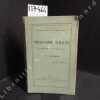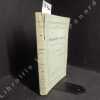-
Type
Art print (2)
Book (5984)
Magazine (21)
Manuscript (1)
Photographs (3)
-
Latest
Last 24h (1)
Last month (18)
Last week (1)
-
Language
English (10)
French (5997)
German (1)
Greek (1)
Latin (2)
-
Century
16th (3)
17th (11)
18th (253)
19th (909)
20th (3044)
21st (135)
-
Countries
Belgium (242)
Brazil (2)
Canada (3)
Côte d'Ivoire (11)
Denmark (1387)
France (4022)
Italy (38)
Switzerland (306)
-
Syndicate
ALAC (3)
CLAM (2)
ILAB (4298)
NVVA (149)
SLACES (149)
SLAM (2710)
SNCAO (15)
Sur la Théorie des Variations des Latitudes.
Berlin, Stockholm, Paris, Beijer, 1899. 4to. Without wrappers as extracted from ""Acta Mathematica. Hrdg. von G. Mittag-Leffler."", Bd. 22, pp. 201-357.
First edition. As the north and south poles, instead of being fixed points on the earth's surface, wander round within a circle of ab. 5o ft. in diameter, the result is a variability of terrestial latitudes generally. Volterra gives an elaborate mathematical analysis of these yearly fluxtuations.
La théorie de la relativité Tome II La relativité générale et la théorie de la gravitattion d'Einstein
Gauthier-Villars. 1926. In-8. Relié. Bon état, Coins frottés, Dos satisfaisant, Intérieur frais. 318 pages.. . . . Classification Dewey : 530-Physique
Etiquette sur coiffe en pied. Tampon bibliothèque. 2 photos disponibles. Classification Dewey : 530-Physique
Lehrbuch der Experimentalphysik
J. Ambrosius Barth, 1908 14,5 x 22,5, 631 pp., 438 figures, 1 spectre couleur, cartonné, Etat moyen - reliure usagée, 16ème édition revue et augmentée par König (Dr.W.)
Bewegung/ feste Körper - Fessigkeiten/ Gase - Wärme/ Magnetismus - Elektrizität/ elektrische Ströme - Wellen und Schall/ Licht
Beweis des Ergodensatzes und des H-Theorems in der neuen Mechanik.
Berlin, Springer, 1929. 8vo. In contemporary half cloth with gilt lettering to spine. In ""Zeitschrift für Physik"", bd. 57, 1929. Entire issue offered. Library stamp to front free end-paper, otherwise fine and clean. Pp. 30-70. [Entire volume:VII, (1), 872 pp.].
First printing of Neumann's important formulation and proof of an ergodic theorem for quantum systems.""The basic principle of this work is to define quantum analogues of cells in phase space by considering sets of quantum states for which all macroscopic quantities have given values within a certain inaccuracy. One further considers the unitary transformation u relating these quantum states to the eigenstates of the hamiltonian. The ergodicity is then established for ""almost every"" value of the transformation u. Although the latter restriction is a rather unsatisfactory one from the physical standpoint, one must consider von Neumann's ergodic theorem as one of the very few important contributions to a most difficult subject which even now is far from complete clarification."" (Hove, Von Neumann's Contributions to Quantum Theory, p. 98).
Beweis des Ergodensatzes und des H-Theorems in der neuen Mechanik.
Berlin, Springer, 1929. 8vo. In contemporary half cloth with gilt lettering to spine. In ""Zeitschrift für Physik"", bd. 57, 1929. Entire issue offered. Library stamp to front free end-paper and light wear to spine, otherwise fine and clean. Pp. 30-70. [Entire volume:VII, (1), 872 pp.].
First printing of Neumann's important formulation and proof of an ergodic theorem for quantum systems.""The basic principle of this work is to define quantum analogues of cells in phase space by considering sets of quantum states for which all macroscopic quantities have given values within a certain inaccuracy. One further considers the unitary transformation u relating these quantum states to the eigenstates of the hamiltonian. The ergodicity is then established for ""almost every"" value of the transformation u. Although the latter restriction is a rather unsatisfactory one from the physical standpoint, one must consider von Neumann's ergodic theorem as one of the very few important contributions to a most difficult subject which even now is far from complete clarification."" (Hove, Von Neumann's Contributions to Quantum Theory, p. 98).
Equations fondamentales d'un mélange de n fluides, déduites de la théorie cinétique en tenant compte du diamètre des molécules
Bruxelles, Hayez 1925 32pp., 29cm., extrait de "Académie royale de Belgique. Classe des sciences, mémoires, collection in-4o, deuxième série" tome VI, br.orig., bel état
Introduction de la théorie d’Einstein. Exposé philosophique élémentaire.
Paris, Albin Michel 1922, 185x120mm, 234pages, broché. Bon état.
Pour un paiement via PayPal, veuillez nous en faire la demande et nous vous enverrons une facture PayPal
Introduction à la Théorie d'Einstein
ALBIN MICHEL. 1922. In-12. Broché. Très bon état, Couv. convenable, Dos satisfaisant, Intérieur acceptable. 234 pages.. . . . Classification Dewey : 530-Physique
Exposé Philosophique Elémentaire. Bibliothèque des Sciences Modernes et Sociales. Classification Dewey : 530-Physique
ANNALES DU BACCALAUREAT AVEC MODELES ET SOLUTIONS, SCIENCES PHYSIQUES, 1re ET 2e PARTIES, FASC. I Bis, 1951
Vuibert. 1951. In-12. Broché. Bon état, Couv. légèrement passée, Dos fané, Intérieur acceptable. 191 pages.. . . . Classification Dewey : 530-Physique
Fascicule I bis. Séries Mathématiques et Mathématiques et Technique. Classification Dewey : 530-Physique
Die Zustandsgleichung. Rede gehalten am 12. Dez. 1910 in Stockholm bei Empfang des Nobelpreises für Physik.
Leipzig, Akademische Verlagsgesellschaft, 1911. Uncut in orig. printed wrappers. 24 pp.
First edition. Waals was awarded the Nobel Prize for Physics in 1910 for his equation, linking pressure, absolute temperature and volume, ""The van der Waals-equation"".
Die Wissenschaft und die Gefährdete Welt. Eine wissenschaftssoziologie der Atomphysik. Zweite, durchgesehene und ergänzte Auflage.
München, Beck'sche Verlagsbuchh., 1969. Orig. full cloth. VIII,582 pp.
Le Carnaval de la Physique
Paris, Dunod, 1980. In-8 (255x175mm) broché ; 257 p. Bon état général.
Le carnaval de la physique l'explication des phénomènes physiques en 610 questions et sans formules
Dunod. 1980. In-8. Broché. Bon état, Coins frottés, Dos satisfaisant, Intérieur frais. 257 pages augmentées de nombreux schémas en noir et blanc dans texte.. . . . Classification Dewey : 530-Physique
Classification Dewey : 530-Physique
Zur Frage der Einwirkung der Wärmebewegung auf die Interferenz von Röntgenstrahlen. - [THE DEBYE-WALLER FACTOR]
Berlin, Springer, 1923. 8vo. Bound in contemporary half cloth with gilt lettering, In ""Zeitschrift für Physik"", Band 17, 1923. Library stamp to title page, otherwise fine and clean. Pp. 398-408. [Entire volume offered: IV, 424 pp.].
First printing of the complete and accurate Debye-Waller factor. Peter Debye introduced the concept in 1913 but it was not untill Waller in 1923 with the present publication gave the complete fully usefull Debye-Waller factor.The Debye-Waller factor is the ratio of the coherent scattering or absorption cross section of a photon or electron by particles bound in a complex system to the value for the same process on an analgous free particle. It is often interpreted also as the probability of the coherent process, normalized to unity, with the difference between unity and the Debye Waller factor interpreted as the probability of incoherent processes.
Linienstrukturen an Bruchflächen. - [MODERN FORENSIC SCIENCE - WALLNER LINES]
Berlin, Springer, 1939. 8vo. In contemporary halv cloth with gilt lettering to spine. In ""Zeitschrift für Physik"", Bd. 114, 1939. Entire volume offered. Stamp to front free end-paper and titlepage, otherwise fine and clean. Pp. 368-78. [Entire volume: VIII, 749 pp.].
First printing of Wallner's important paper on microscopic lines - Wallner Lines - in various materials. Wallner lines are microscopic fractures that propagate on a rigid surface. Using the Wallner lines, it is possible to determine the speed at which a surface is cracked. The method works for example on glass, epoxy, tungsten and carbon-filled rubber. The measurement of Wallner lines are a standard method of modern forensic science.
Linienstrukturen an Bruchflächen. - [MODERN FORENSIC SCIENCE - WALLNER LINES]
Berlin, Springer, 1939. 8vo. In contemporary halv cloth with gilt lettering to spine. In ""Zeitschrift für Physik"", Bd. 114, 1939. Entire volume offered. Stamp to front free end-paper. Fine and clean. Pp. 368-78. [Entire volume: VIII, 749 pp.].
First printing of Wallner's important paper on microscopic lines - Wallner Lines - in various materials. Wallner lines are microscopic fractures that propagate on a rigid surface. Using the Wallner lines, it is possible to determine the speed at which a surface is cracked. The method works for example on glass, epoxy, tungsten and carbon-filled rubber. The measurement of Wallner lines are a standard method of modern forensic science.
Institutiones Philosophicae, quas in usum Auditorum suorum elucubratus est P. Henricus Walser. Liber V. Physica Generalis.
Augustae Vindelicorum (Augsburg), Rieger, 1795. Contemp. blue boards, a little rubbed. VIII,485,(3) pp. and 5 folded engraved plates. Some brownspots and last leaves a bit dampstained. One plate frayed in outer margin. Plates with dampstaining.
Last, independent, volume of Walser's general handbook in 5 volumes, this part deals with Physics.
La protection sélective des réseaux H.T. par relais de distance.
Paris, Dunod, 1936. 17 x 25, 231 pp., 167 figures, broché, très bon état.
traduit de l'allemand par R. Nierenberger.
Physik. Bearbeitet von F. Auerback (etc.) Mit 106 Abb. im Text.
Leipzig und Berlin, Teubner, 1915. Lex8vo. Orig. full cloth, gilt. Light wear to extremities. VIII,762 pp.
With 2 first printings by Albert Einstein (Weil Nos 70 and 71), 2 by Max Planck and 1 by H.A. Lorentz and 1 by P. Zeeman. (Die Kultur der Gegenwart dritter Theil, 3. Abth.).
Conference organized in Collab.with the Intern.Union of Physics a. The Polish Intellectual Co.Operation Committee. Warsaw, May 30th-June 3rd 1938.
Paris,(1939). Orig.full cloth. XX,247 pp. - First edition with contributions by N.Bohr, L.de Broglie, O.Klein, H.A.Kramers, L.Brillouin, A.S.Eddington, E.A.Milne a.others
Contribution, du point de vue de la mécanique ondulatoire, à l'étude du deuxième théorème de la thermodynamique -- EDITION ORIGINALE
P., Hermann, 1935, un volume in 8, broché, couverture imprimée, 93pp.
---- EDITION ORIGINALE DE LA THESE DE DOCTORAT ES SCIENCES PHYSIQUES présenté par Satosi WATANABE à la Faculté des sciences de Paris**8270/M3
On a General Law of Density in Saturated Vapours. Received June 19, 1851, - Read June 19, 1851.
(London, Richard Taylor and William Francis, 1852). 4to. No wrappers as extracted from ""Philosophical Transactions"" 1852 - Part I. Pp. 83-85 a. 1 engraved plate
First printing. Waterston was one of the pioneers on the kinetic theory of gases although his importent work was looked down on by the Royal Society at the time.
LES MERVEILLES DE LA SCIENCE - GEOLOGIE ASTRONOMIE MATHEMATIQUES / PHYSIQUE CHIMIE BIOLOGIE SCIENCE APPLIQUES
EDITIONS DES DEUX COQS D OR. 1959. In-4. Relié. Etat d'usage, Couv. convenable, Dos abîmé, Intérieur frais. 211 pages augmentées de nombreuses illustrations en couleur dans et hors texte - Coiffes abimées -. . . . Classification Dewey : 530-Physique
Classification Dewey : 530-Physique
Index of Spectra. With a Preface by H.E. Roscoe.
London, Henry Gulman, 1872. Cont. hcalf. Gilt back and gilt cover. Chromolithographed frontispiece. XVI,74 pp. and 8 plates.
First edition.
La physionomie humaine, son mécanisme et son rôle social.
1907 A Paris, Félix Alcan, Editeur, Collection "Bibliothèque de Philosophie Contemporaine" - 1907 - In-8, broché - 320 p.
Etat moyen - Couverture défraîchie - Plis de lecture au dos - Dos gauchi - Rares annotations en marge au crayon à papier - Premier feuillet en voie de désolidarisation
 Write to the booksellers
Write to the booksellers








